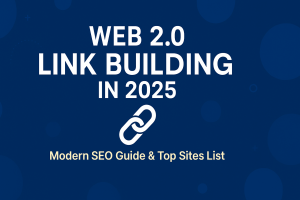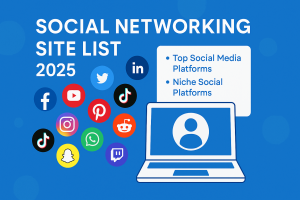High-Authority Profile Sites (2025): Smart Linking that Actually Helps SEO
Profile creation still works—when you treat it like brand building, not a shortcut. In 2025, search engines care about who you are, where you’re mentioned, and whether your profiles help users. The goal isn’t to collect hundreds of weak links; it’s to build a clean, consistent brand footprint on trusted sites and niche hubs.
Quick take: quality > quantity. Choose relevant platforms, complete your profile, and make sure the page is indexable.
What is Profile Linking (in 2025)?
Profile linking means creating a public profile for your brand on trusted platforms—business networks, communities, directories—and adding your website link. Done well, it:
- Confirms your brand/entity across the web (consistency matters).
- Generates referral clicks and branded searches.
- Supports rankings by strengthening trust signals—especially for local and B2B.
What changed since the old days? Search prioritizes relevance, quality, and user value, not raw volume. A handful of good profiles beats a hundred low-quality ones.
How to Use Profile Creation Sites the Right Way
Step-by-step setup
- Pick platforms with purpose: industry fit + real users.
- Use a brand kit: logo, short/long bios, brand colors, cover image.
- Consistent NAP: name, address, phone—exact match across profiles.
- Add your main site URL (no UTM). Use the same canonical homepage URL you use everywhere.
- Complete everything: tagline, categories, services, hours, social links.
- Post once: a pinned intro or “about” update where the platform allows.
Optimization tips
- Natural keywords: one or two phrases your customers actually use.
- Media: add 3–6 images (logo, team, product), short video if supported.
- Indexability check: make sure the profile page isn’t noindexed and isn’t hidden behind a login.
- Internal consistency: the same brand story across LinkedIn, Crunchbase, etc.
- Track referral clicks in GA4 (traffic → referrals). Measure, don’t guess.
Want a full off-page plan that includes outreach? See our link building services.
How to Evaluate a Profile Site Before You Invest Time
Signals of a good platform
- Brand-safe and moderated (no obvious spam).
- Profiles are public, crawlable, and indexed in Google.
- Category/tag pages exist—your profile can be discovered.
- Real users: comments, follows, or product usage.
- Relevance: it fits your industry or audience.
What to avoid
- Auto-approve spammy directories and “link farm” lists.
- Sites where the profile page is blocked by robots or noindex.
- Low-effort clones that copy Wikipedia or Crunchbase content.
- Anything that sells “do-follow” profile links—risky and pointless.
| Check | How to verify fast |
|---|---|
| Indexable? | Open the profile → View Source → no noindex. Or try site:yourprofileurl after a few days. |
| Link attribute | Inspect the link; many use rel="nofollow" or rel="ugc". That’s fine. The entity signal still helps. |
| Quality | Scan a few profiles. If they look spammy, skip the site. |
| Discovery | Does the site have search, tags, or category pages where users can find you? |
High-Authority Profile Sites (Curated for 2025)
Below are trusted platforms across business, creative, tech, Q&A, and local. Link attributes can change—treat this as a starting point and always verify.
| # | Platform | Typical purpose | Typical link attribute | Notes |
|---|---|---|---|---|
| 1 | Company & team profiles | nofollow/ugc | Must-have for brand trust and recruiting. | |
| 2 | Medium | Publisher bio + stories | nofollow/ugc | Republish selected articles; add canonical if applicable. |
| 3 | About.me | Personal/brand hub | mixed | Simple one-page presence with clean bio. |
| 4 | Behance | Creative portfolio | nofollow/ugc | Great for design-heavy brands. |
| 5 | Visual discovery | nofollow | Strong referral traffic for lifestyle categories. | |
| 6 | GitHub | Dev organization page | nofollow | Relevant if you ship software or tools. |
| 7 | Crunchbase | Company profile | nofollow | Good for B2B credibility and entity signals. |
| 8 | Dribbble | Design portfolio | nofollow/ugc | Great for agencies and creatives. |
| 9 | Quora | Expert profile + answers | nofollow/ugc | Answer niche questions; referral traffic potential. |
| 10 | SoundCloud | Audio/brand channel | nofollow | Useful for podcasts and audio brands. |
| 11 | Product Hunt | Product/company profile | nofollow | Launch visibility for tech products. |
| 12 | AngelList | Startup & jobs profile | nofollow | Good for hiring and investor research. |
| 13 | SlideShare | Decks + company profile | nofollow | Repurpose webinars and talks. |
| 14 | Brand/user profile | nofollow/ugc | Be helpful, not promotional; subreddits have rules. | |
| 15 | Goodreads (authors) | Author/publisher pages | nofollow | Niche but strong for publishing. |
| 16 | Bandcamp | Artist/label profiles | nofollow | For music brands and audio catalogs. |
| 17 | Houzz | Home/design professionals | nofollow | Local service discovery; reviews help. |
| 18 | Tripadvisor (hospitality) | Hotels, tours, attractions | nofollow | Crucial for travel/hospitality niches. |
| 19 | Yelp | Local business profile | nofollow | Reviews drive local trust and clicks. |
| 20 | Crunchbase (again) | Duplicate row to remind: maintain it | nofollow | Keep funding/team updates fresh—search picks this up. |
Link attributes like nofollow or ugc are normal on large platforms. They still help with entity signals, branded queries, and referral traffic.
What Benefits Can You Expect?
SEO & discovery
- Stronger brand/entity signals across the web.
- More branded searches and higher CTR on your name.
- Safer link acquisition compared to spammy directory blasts.
Marketing impact
- Referral clicks from real audiences.
- Better social proof for sales and partnerships.
- Owned profiles you can update during campaigns.
Common Mistakes to Avoid
- Chasing “do-follow only” lists: big platforms often use nofollow/ugc. That doesn’t kill value.
- Copy-pasting the same bio everywhere: write short and long versions; vary slightly per audience.
- Thin or incomplete profiles: fill every field—categories, services, media, social links.
- Spam directories and link farms: low quality risks manual actions; skip them.
- UTMs on your main profile link: use a clean canonical URL; track referral traffic in GA4.
If you need a safe, modern off-page plan, check our SEO services.
What’s Next for Profile Linking?
- Entity-first search: consistent profiles feed knowledge panels and brand understanding.
- Richer media: short video and carousels inside profiles improve engagement and discovery.
- Niche networks: smaller, industry-specific platforms carry more weight than “general lists.”
- Verification: platforms push ID/brand verification—trust wins.
FAQ
Do profile links need to be “do-follow” to help?
No. Nofollow/UGC links still support brand signals, discovery, and referral traffic. A natural mix is safer and looks normal.
How many profiles should I build?
Start with 10–15 strong, relevant platforms. Maintain them. Add niche sites over time—quality beats volume.
How do I know if my profile is indexed?
Use Search Console “URL inspection” or a site: search after a few days. If it never indexes, that platform may block profiles.
Can I use exact-match anchor text?
Most profile links use your brand name or a plain URL. That’s fine—and safer. Save keywords for editorial links from content.
Want a Clean, Safe Profile Footprint—Without the Busywork?
Done-for-you setup
- We pick the right platforms for your niche and market.
- Write and design complete profiles (copy + images).
- Fix NAP inconsistencies and track referral clicks.
Full SEO growth plan
- Technical cleanup, content plan, and safe link acquisition.
- Local maps growth where relevant.
- Monthly reporting that’s easy to read.
Prefer organic + paid together? Our Google Ads management can amplify launches and seasonal pushes while organic compounds.
Talk to VJ SEO Marketing
Tell us about your goals, timelines, and what’s blocking growth. We’ll suggest a plan that fits your market and budget.


